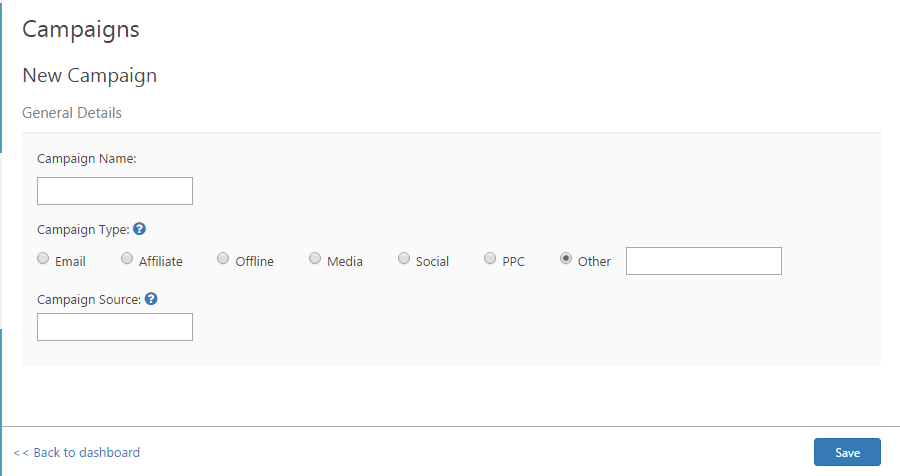With campaign tracking you can create shortened tracking links, group these URLs logically, and monitor the number of clicks they receive in order to measure the success of your campaign. You can deliver customized content or a specific survey to engage campaign visitors.
You can also define conversion tags in order to notify your affiliates when goal conversions take place.
- Create tracking links for online and offline campaigns
- Use friendly, short and configurable tracking links
- Add conversion tags (or pixels) to campaigns in order to notify affiliates and publishers whenever a visitor converts
- Create personalized content to display visitors arriving from campaigns
- Deliver a specific survey to visitors arriving from campaigns
Campaigns dashboard
How to Add a New Campaign
- On the main Campaigns page, click Add Campaign.
- Fill in the name of the campaign, along with its type and source. The type and the source provide specific information about the campaign.
Campaign Name - The campaign name should describe the campaign you are running. Here you can specify the promotion or the campaign slogan. For example, if you're running a special promotion for Summer, you might identify the campaign as "Summer Sale".
Campaign Type - The medium the campaign is using. For example, if you're driving traffic from a newsletter, the campaign medium should be Email.
Campaign Source - Traffic from campaigns have an origin or source. This source can be a site the visitor came from, or the name of a newsletter or a search engine. For example, if you create a campaign for a specific web-site and you are placing ads there, the source will be the name of that site.
For example:
- Campaign Name - Twitter
- Campaign Type - Social
- Campaign Source - twitter.com
Add Campaign dialog - Click Save and two new items will appear at the bottom of the window.
Tracking links and Pixels - Add a new tracking link by filling in the parameters and by creating its shortened link.
For each tracking link, you can define two extra fields: Term and Content. These two fields allow you to more thoroughly describe the campaign. For example, for a display (banner ad) campaign, you can use the Term field to specify the size of the banner (250x250, skyscraper etc) or the placement of the banner (Header, Sidebar, Popup etc). The Content field helps describe the type of ad or other identifying notes.
You may also choose to create a new Visitor Segment for anyone who clicks on this tracking link. All campaigns automatically create a new Visitor Segment when activated, this allows you to create a new Segment for each tracking link.
Tracking Link dialog
Note: Clicks are counted when a user clicks the tracking link the first time. If the user clicks the tracking link again it will not count unless the user clears their cache, has disabled their cache, or clicks the link from a different browser or device..
- Add a new Pixel for your affiliates.
Some of the publishers require a conversion tag, or pixel, to be placed in specific conversion points on your site. For example CPA campaigns and working with blind networks often require it. Using The SharePoint Marketing Suite pixel support, you can define the conversion tag or the pixel you want the Marketing Suite to use when a certain goal is completed.Use [KEY] and [Random] to define dynamic property and cache busterSome publishers rely on cookies, while others rely on data passed to the advertiser when they redirect visitors to the landing page. If your publishers use the second method (passing dynamic data to the landing page), please instruct them to send the information they want to receive in a parameter called "CDP" (for example, the URL of the landing page will look like this: http://yourshorturldomain.com/sf23SAv?CDP=12345). Now, all you have to do is create the pixel and use the placeholder [KEY] to define where you want us to place the value we obtained (12345). For example: http://publisherdomain.com/pixel.php?value=[KEY] - that way, when we initiate a pixel call, we will replace [KEY] with the relevant value for that specific visitor.Use the [Random] placeholder to add a cache buster parameter to the pixel in case the publisher requests it. For example, http://publisherdomain.com/pixel.php?value=[KEY]&r=[Random]. The [Random] placeholder will be replaced with a random number to avoid caching issues on the visitor browser or CDN.
Pixel Dialog - Make sure to click Save on the Tracking Links and Pixel dialogs when done.
- Once you have finished editing the campaign click Save from the Campaign main window.
Note - When adding a campaign, a new visitor segment is created for it, which can be used in web analytics Reports widgets, Behavioral Targeting and Voice of Customer. See Visitor Segments for more information.
How to Add Personalized Content to a Campaign
- Click the name the Campaign you would like to edit from the Campaign main window.
- On the Campaign page, click Personalize Content in the upper right hand corner.
- In the popup dialog, fill in the Page parameter by opening the Object Explorer elipses and selecting an item.
- Choose UI Elements or Create a new UI Element.
- Choose the Segment you would like to target, A segment is built from one or more conditions including Traffic source, Visitor Type, Goals, Visits, Last seen, Browser and OS, User agent, Country, URL, Referrer, Cookie, AB or Multivariable Test.
- Name it with a Title.
- Click Save.
Add Personalized Content Dialog
Note: Using this module requires configuration (See how to configure Shorten Links).




